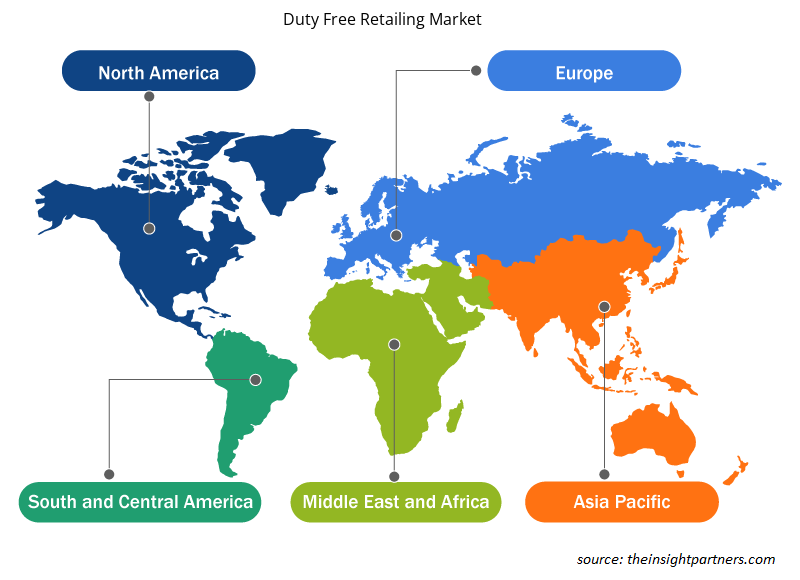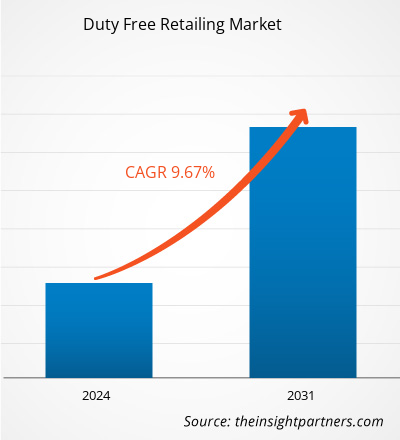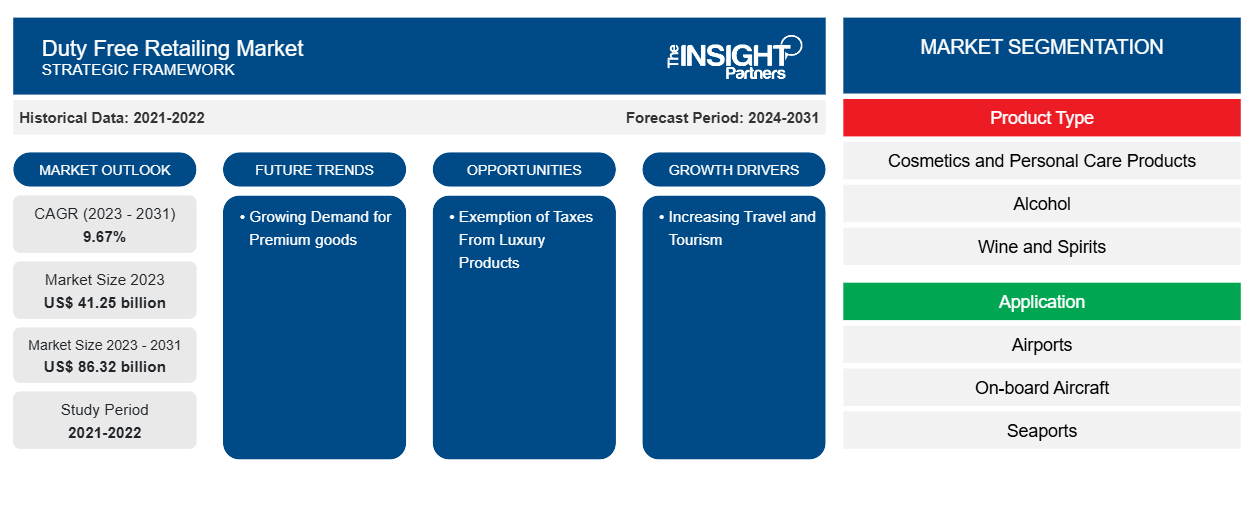Der Duty-Free-Einzelhandelsmarkt soll von 41,25 Milliarden US-Dollar im Jahr 2023 auf 86,32 Milliarden US-Dollar im Jahr 2031 anwachsen. Der Duty-Free-Einzelhandelsmarkt soll in den Jahren 2023–2031 eine durchschnittliche jährliche Wachstumsrate (CAGR) von 9,67 % verzeichnen. Der zunehmende Rückgang von Luxusprodukten und One-Stop-Shopping.
Duty-Free-Einzelhandel-Marktanalyse
Wachsende Investitionen und Entwicklung der Reise- und Tourismusbranche, gepaart mit der Integration von Segmenten wie Gastgewerbe und Infrastruktur mit staatlicher Unterstützung zur Förderung der Reise- und Tourismusbranche , führen zum Wachstum des Duty-Free-Einzelhandelsmarktes.
Überblick über den Duty-Free-Einzelhandelsmarkt
Der Duty-Free-Shop bezieht sich auf Verkaufsstellen, die Waren anbieten, die von der Zahlung bestimmter nationaler und lokaler Steuern befreit sind. Diese Steuerbefreiung senkt die Preise im Vergleich zu normalen Einzelhandelsgeschäften. Duty-Free-Verkaufsstellen bieten Reisenden die Möglichkeit, bei verschiedenen Produkten wie Alkohol, Parfüm, Tabak, Kosmetika, Elektronik und vielem mehr Geld zu sparen. Die Ersparnis kann erheblich sein, insbesondere bei teuren Luxusartikeln. Diese Duty-Free-Shops sind strategisch günstig in den Terminals internationaler Flughäfen gelegen, sodass sie für Reisende, die aus anderen Ländern abfliegen oder ankommen, leicht zugänglich sind. Wenn Passagiere also Dinge einkaufen möchten, die sie während ihrer Reise benötigen, oder Souvenirs und Geschenke für Freunde und Familie kaufen möchten, können sie dies problemlos in diesen Duty-Free-Shops tun.
Passen Sie diesen Bericht Ihren Anforderungen an
Sie erhalten kostenlose Anpassungen an jedem Bericht, einschließlich Teilen dieses Berichts oder einer Analyse auf Länderebene, eines Excel-Datenpakets sowie tolle Angebote und Rabatte für Start-ups und Universitäten.
-
Holen Sie sich die wichtigsten Markttrends aus diesem Bericht.Dieses KOSTENLOSE Beispiel umfasst eine Datenanalyse von Markttrends bis hin zu Schätzungen und Prognosen.
Treiber und Chancen im Duty-Free-Einzelhandel
Steuerbefreiung für Luxusgüter soll den Markt begünstigen
Die zollfreien Artikel ermöglichen es den Verbrauchern, Luxus- und High-End-Waren zu zollfreien Preisen zu erwerben. Bei einem hektischen Lebensstil bevorzugen die Verbraucher das One-Stop-Shopping, und ein solcher zollfreier Einzelhandel hilft ihnen, besser und luxuriöser einzukaufen. Luxusgüter wie Parfüms, Uhren, Zigarren, hochwertiger Alkohol, Modeschmuck und andere sind die attraktivsten Artikel in Duty-Free-Shops zu günstigeren Preisen, was die Verbraucher anzieht. Darüber hinaus eröffnen verschiedene Länder zollfreie Luxus-Einzelhandelsgeschäfte. So eröffnete beispielsweise im November 2021 Louis Vuitton, ein zollfreies Luxusartikelgeschäft, auf der Luxusinsel Hainan. Diese Neigung zu zollfreien Luxusprodukten treibt also das Wachstum des Duty-Free-Einzelhandelsmarktes voran.
Zunehmendes Reisen und Tourismus
Laut dem ersten Welttourismusbarometer der Welthandelsorganisation der Vereinten Nationen (UNWTO) des Jahres lag der internationale Tourismus 2023 bei 88 %, mit geschätzten 1,3 Milliarden internationalen Ankünften. Das neueste UNWTO-Welttourismusbarometer bietet einen vollständigen Überblick über die Leistung des Sektors im Jahr 2023 und zeichnet die Erholung nach globalen Regionen, Unterregionen und Reisezielen nach. Die internationalen Tourismuseinnahmen erreichten im Jahr 2023 vorläufigen Schätzungen zufolge 1,4 Billionen US-Dollar. Darüber hinaus wird der chinesische Aus- und Einreisetourismus im Jahr 2024 voraussichtlich aufgrund von Visaerleichterungen und verbesserten Flugkapazitäten zunehmen. China beantragt die visumfreie Einreise für Bürger aus Frankreich, Italien, Deutschland, den Niederlanden, Spanien und Malaysia für ein Jahr bis zum 30. November 2024. Europa wird voraussichtlich 2024 erneut die Nase vorn haben. Im März traten Rumänien und Bulgarien dem Schengen-Raum bei und Paris wird im Juli und August 2024 Gastgeber der Olympischen Sommerspiele sein. Solche Erleichterungen für zunehmendes Reisen und Tourismus werden das internationale Reisen ankurbeln, was Möglichkeiten für das Wachstum des Duty-Free-Einzelhandelsmarktes schafft.
Duty-Free-Einzelhandel-Marktbericht Segmentierungsanalyse
Wichtige Segmente, die zur Ableitung der Analyse des Duty-Free-Einzelhandelsmarktes beigetragen haben, sind Produkttyp und Anwendung.
- Basierend auf dem Produkttyp ist der Duty-Free-Einzelhandelsmarkt in Kosmetika und Körperpflegeprodukte, Alkohol, Wein und Spirituosen, Tabak und Zigaretten, Mode, Süßwaren und Lebensmittel und Sonstiges unterteilt.
- Basierend auf der Anwendung ist der Duty-Free-Einzelhandelsmarkt in Flughäfen, Flugzeuge, Seehäfen und andere segmentiert.
Duty-Free-Einzelhandel Marktanteilsanalyse nach Geografie
Der geografische Umfang des Berichts zum Duty-Free-Einzelhandelsmarkt ist hauptsächlich in fünf Regionen unterteilt: Nordamerika, Asien-Pazifik, Europa, Naher Osten und Afrika sowie Südamerika/Süd- und Mittelamerika. Der globale Duty-Free-Einzelhandel mit zunehmendem Reise- und Tourismusverkehr und Wachstum der Flughafeninfrastruktur. Im August 2023 prognostizierte Airports Council International (ACI) World ein durchschnittliches jährliches Wachstum des Passagierverkehrs von 5,8 % zwischen 2022 und 2040. Bis 2040 werden jährlich mehr als 19 Milliarden Passagiere über Flughäfen weltweit reisen. Im November 2023 berichtete Airport Council International, dass die Region Asien-Pazifik ein erhebliches Potenzial für die Luftfahrt hat, da 57 % der 300 geplanten Flughäfen weltweit in dieser Region entstehen. Ein solches Wachstum bei Flughäfen und Passagierverkehr schafft also eine lukrative Gelegenheit für das Wachstum des Duty-Free-Einzelhandelsmarktes.
Regionale Einblicke in den Duty-Free-Einzelhandelsmarkt
Die regionalen Trends und Faktoren, die den Duty-Free-Einzelhandelsmarkt während des Prognosezeitraums beeinflussen, wurden von den Analysten von Insight Partners ausführlich erläutert. In diesem Abschnitt werden auch die Marktsegmente und die Geografie des Duty-Free-Einzelhandels in Nordamerika, Europa, im asiatisch-pazifischen Raum, im Nahen Osten und Afrika sowie in Süd- und Mittelamerika erörtert.

- Erhalten Sie regionale Daten zum Duty-Free-Einzelhandelsmarkt
Umfang des Duty-Free-Einzelhandelsmarktberichts
| Berichtsattribut | Details |
|---|---|
| Marktgröße im Jahr 2023 | 41,25 Milliarden US-Dollar |
| Marktgröße bis 2031 | 86,32 Milliarden US-Dollar |
| Globale CAGR (2023 - 2031) | 9,67 % |
| Historische Daten | 2021-2022 |
| Prognosezeitraum | 2024–2031 |
| Abgedeckte Segmente |
Nach Produkttyp
|
| Abgedeckte Regionen und Länder |
Nordamerika
|
| Marktführer und wichtige Unternehmensprofile |
|
Dichte der Akteure im Duty-Free-Einzelhandel: Die Auswirkungen auf die Geschäftsdynamik verstehen
Der Duty-Free-Einzelhandelsmarkt wächst rasant, angetrieben von der steigenden Nachfrage der Endverbraucher aufgrund von Faktoren wie sich entwickelnden Verbraucherpräferenzen, technologischen Fortschritten und einem größeren Bewusstsein für die Vorteile des Produkts. Mit steigender Nachfrage erweitern Unternehmen ihr Angebot, entwickeln Innovationen, um die Bedürfnisse der Verbraucher zu erfüllen, und nutzen neue Trends, was das Marktwachstum weiter ankurbelt.
Die Marktteilnehmerdichte bezieht sich auf die Verteilung der Firmen oder Unternehmen, die in einem bestimmten Markt oder einer bestimmten Branche tätig sind. Sie gibt an, wie viele Wettbewerber (Marktteilnehmer) in einem bestimmten Marktraum im Verhältnis zu seiner Größe oder seinem gesamten Marktwert präsent sind.
Die wichtigsten Unternehmen auf dem Duty-Free-Einzelhandelsmarkt sind:
- Aer Rianta International (ARI)
- China Duty-Free-Gruppe Co., Ltd.
- Dubai Duty-Free
- Duty-Free-Shops in Amerika
- Gebr. Heinemann
- King Power International Gruppe
Haftungsausschluss : Die oben aufgeführten Unternehmen sind nicht in einer bestimmten Reihenfolge aufgeführt.

- Erhalten Sie einen Überblick über die wichtigsten Akteure auf dem Duty-Free-Einzelhandelsmarkt
Neuigkeiten und aktuelle Entwicklungen im Duty-Free-Einzelhandelsmarkt
Der Duty-Free-Einzelhandelsmarkt wird durch die Erhebung qualitativer und quantitativer Daten nach Primär- und Sekundärforschung bewertet, die wichtige Unternehmensveröffentlichungen, Verbandsdaten und Datenbanken einbezieht. Im Folgenden finden Sie eine Liste der Entwicklungen auf dem Markt:
- Im März 2024 gab Mumbai Travel Retail Private Limited (MTRPL) seine Umbenennung in OSPREE bekannt. Die neue Markenidentität „Ospree“ dient als Strategie von MTRPL zur Integration aller Duty-Free-Beteiligungen, darunter Mumbai, Amritsar, Lucknow, Thiruvananthapuram, Jaipur, Ahmedabad und Mangalore.
(Quelle: Mumbai Travel Retail Private Limited, Pressemitteilung, 2024)
- Im Januar 2024 kündigte Mumbai Duty Free einen Nappa Dori-Store im Abflugbereich des Chhatrapati Shivaji Maharaj International Airport an und markierte damit den Einstieg der Marke in den Reiseeinzelhandel. Nappa Dori, was übersetzt Leder und Faden bedeutet, ist eine Marke indischen Ursprungs, die für ihre handgefertigten Lederwaren und Accessoires bekannt ist.
(Quelle: Mumbai Duty Free, Pressemitteilung, 2024)
Bericht zum Duty-Free-Einzelhandelsmarkt: Umfang und Ergebnisse
Der Bericht „Duty-Free-Einzelhandel – Marktgröße und -prognose (2021–2031)“ bietet eine detaillierte Analyse des Marktes, die die folgenden Bereiche abdeckt:
- Marktgröße und Prognose auf globaler, regionaler und Länderebene für alle wichtigen Marktsegmente, die im Rahmen des Projekts abgedeckt sind
- Marktdynamik wie Treiber, Beschränkungen und wichtige Chancen
- Wichtige Zukunftstrends
- Detaillierte PEST/Porters Five Forces- und SWOT-Analyse
- Globale und regionale Marktanalyse mit wichtigen Markttrends, wichtigen Akteuren, Vorschriften und aktuellen Marktentwicklungen
- Branchenlandschaft und Wettbewerbsanalyse, einschließlich Marktkonzentration, Heatmap-Analyse, prominenten Akteuren und aktuellen Entwicklungen
- Detaillierte Firmenprofile
- Historische Analyse (2 Jahre), Basisjahr, Prognose (7 Jahre) mit CAGR
- PEST- und SWOT-Analyse
- Marktgröße Wert/Volumen – Global, Regional, Land
- Branchen- und Wettbewerbslandschaft
- Excel-Datensatz
Aktuelle Berichte
Erfahrungsberichte
Grund zum Kauf
- Fundierte Entscheidungsfindung
- Marktdynamik verstehen
- Wettbewerbsanalyse
- Kundeneinblicke
- Marktprognosen
- Risikominimierung
- Strategische Planung
- Investitionsbegründung
- Identifizierung neuer Märkte
- Verbesserung von Marketingstrategien
- Steigerung der Betriebseffizienz
- Anpassung an regulatorische Trends























 Kostenlose Probe anfordern für - Duty-Free-Einzelhandelsmarkt
Kostenlose Probe anfordern für - Duty-Free-Einzelhandelsmarkt